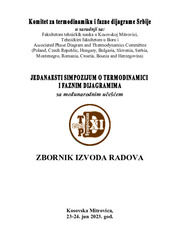Prikaz osnovnih podataka o dokumentu
Influence of mould preheating on solidification stress of railway aluminothermic welding by casting simulation aluminothermic welding by casting simulation
| dc.contributor | Minić, Duško | |
| dc.creator | Jovanović, Gvozden | |
| dc.creator | Manojlović, Vaso | |
| dc.creator | Sokić, Miroslav | |
| dc.creator | Delić, Alen | |
| dc.creator | Gavrilovski, Milorad | |
| dc.date.accessioned | 2023-10-23T14:08:43Z | |
| dc.date.available | 2023-10-23T14:08:43Z | |
| dc.date.issued | 2023 | |
| dc.identifier.isbn | 978-86-81656-63-1 | |
| dc.identifier.uri | https://ritnms.itnms.ac.rs/handle/123456789/941 | |
| dc.description.abstract | Aluminothermic welding has been used to connect railway rails for over a century. This method has several advantages, including its versatility, the tightness of the weld it creates, and its ease of execution. To complete the procedure, no further power source is necessary. The design of the mold with the pouring system, which should ensure even pouring of thermal steel without turbulence, then even heat dissipation or cooling to obtain an appropriat micro and acro structure of steel free of internal and external defects, is one of several factors that contribute to a quality welded joint. As a result, costly experimental techniques in industrial settings were necessary to keep up with the ever-changing mould design. The model design was upgraded in comparison to the previous version [1], and will be imroved even further.The two sets of solid steel rails put on either side of the casting mould will be adjusted as heating media within the mould material category in the future, bringing the model closer to reality. As a result, cooling and heating temperatures will be more evenly distributed. Stress and strain modeling were performed to the preheated model to provide a more complete understanding of how shrinkage is related to stress. In future iterations of the model, we will either move the heat source to its right place approximately 40 cm above ground or adjust the temperature, diameter, and gas at the current site to more exactly reproduce real-life circumstances. Furthermore, during simulation setup, the replace material function may be used to model a new component that represents the divider that will be changed between air and silica sand material at the end of prehearing. Software programs are being used to simulate conventional casting procedures that may be used in the casting of thermite steel during the fabrication of welded railway connections in order to prevent costly and time-consuming industrial experimentation. The NovaFlow & Solid CV software suite [2] was used to simulate casting thermite steel in the mold cavity or weld joint for the 49E1 rail. | sr |
| dc.language.iso | en | sr |
| dc.publisher | Kosovska Mitrovica : Fakultet Tehničkih nauka | sr |
| dc.relation | info:eu-repo/grantAgreement/MESTD/inst-2020/200023/RS// | sr |
| dc.relation | info:eu-repo/grantAgreement/MESTD/inst-2020/200135/RS// | sr |
| dc.rights | openAccess | sr |
| dc.source | Jedanaesti simpozijum o termodinamici i faznim dijagramima | sr |
| dc.title | Influence of mould preheating on solidification stress of railway aluminothermic welding by casting simulation aluminothermic welding by casting simulation | sr |
| dc.type | conferenceObject | sr |
| dc.rights.license | ARR | sr |
| dc.citation.epage | 52 | |
| dc.citation.spage | 51 | |
| dc.identifier.fulltext | http://ritnms.itnms.ac.rs/bitstream/id/1993/bitstream_1993.pdf | |
| dc.type.version | publishedVersion | sr |

